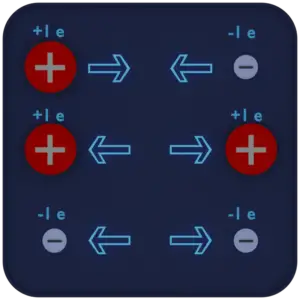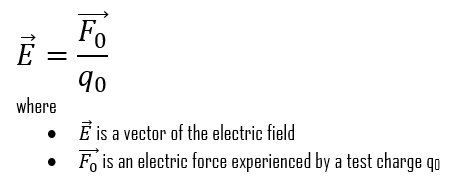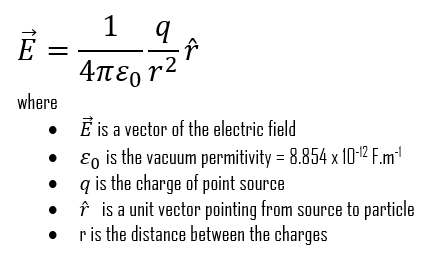30-second summary
Electrostatic Field
The basic concept of electrostatics is a static electric field, which can be described by a vector field of electric field intensity or by a scalar potential.
The derived SI units for the electric field are volts per meter (V/m), exactly equivalent to newtons per coulomb (N/C).
This electrostatic field, and the force it creates, can be illustrated with lines called “lines of force”.
The electric field of any combination of charges is the vector sum of the fields caused by the individual charges.

About Electrostatic Field
Electrostatic fields are electric fields that do not change with time. Such fields are present when systems of charged matter are stationary, or when electric currents are unchanging. The electrostatic field is defined mathematically as a vector field that associates to each point in space the Coulomb force per unit of charge exerted on an infinitesimal positive test charge at rest at that point. This electrostatic field, and the force it creates, can be illustrated with lines called “lines of force” (or field lines). An electric field line is an imaginary line or curve drawn through a region of space so that its tangent at any point is in the direction of the electric-field vector at that point. The number of lines per unit area (perpendicular to their direction) is proportional to the magnitude of electric field at the point.
The basic concept of electrostatics is a static electric field, which can be described by a vector field of electric field intensity or by a scalar potential. The mathematical methods of electrostatics make it possible to calculate the distributions of the electric field and of the electric potential from a known configuration of charges, conductors, and insulators.
The derived SI units for the electric field are volts per meter (V/m), exactly equivalent to newtons per coulomb (N/C).
Charged objects repel or attract each other because of the way these fields act together. This force is present with every charged object. When two objects of opposite charge are brought near one another, the electrostatic field is concentrated in the area between them. The direction of the small arrows shows the direction of the force as it would act upon an electron if it were released into the electric field.

The strength of the attraction or of the repulsion force depends upon two factors:
- the amount of charge on each object,
- the distance between the objects.
The greater the charge on the objects, the greater the electrostatic field. The greater the distance between the objects, the weaker the electrostatic field between them, and vice versa. This leads us to the law of electrostatic attraction, commonly referred to as Coulomb’s Law.
Calculation of Electric Field
Electric field a vector quantity, is the force per unit charge exerted on a test charge at any point. We define the electric field E at a point as the electric force F0 experienced by a test charge q0 at the point, divided by the charge q0 . That is, the electric field at a certain point is equal to the electric force per unit charge experienced by a charge at that point:

Electric field generated by a point source can be then calculated according the following formula:

Superposition of Electric Fields
The electric field of any combination of charges is the vector sum of the fields caused by the individual charges. To calculate the electric field caused by a continuous distribution of charge, divide the distribution into small elements, calculate the field caused by each element, and then carry out the vector sum, usually by integrating.
Example: Electric Charge
Noteworthy, in four liters of water, there is about 2.1 x 108C of total electron charge. Thus, if we place two bottles a meter apart, the electrons in one of the bottles repel those in the other bottle with a force of 4.1 x 1026N. This tremendous force is comparable with the force that the planet Earth would weigh if weighed on another Earth. Ut, as was written, there are also positive (protons) and these charges tend to cancel each other out.
Frequently asked questions
An atom consists of a positively charged nucleus surrounded by negatively charged electrons so that the atom as a whole is electrically neutral. The atomic nucleus consists of positively charged protons and neutral neutrons.
The electrons in an atom are attracted to the protons in the nucleus by the electromagnetic force. This force binds the electrons inside an electrostatic potential well surrounding the smaller nucleus, which means that an external source of energy is needed for the electron to escape.
The coulomb (symbol: C) is the International System of Units (SI) unit of electric charge. The coulomb was defined as the quantity of electricity transported in one second by a current of one ampere: 1 C = 1 A × 1 s

